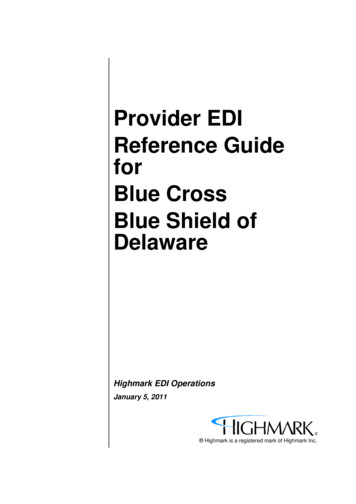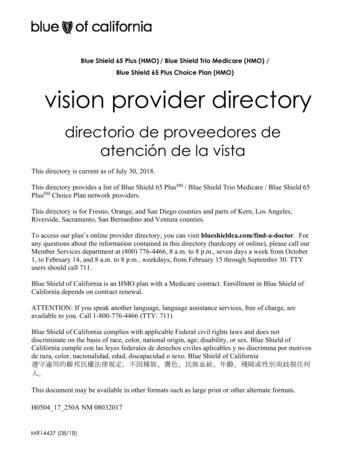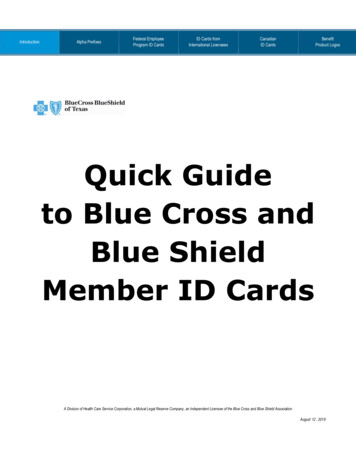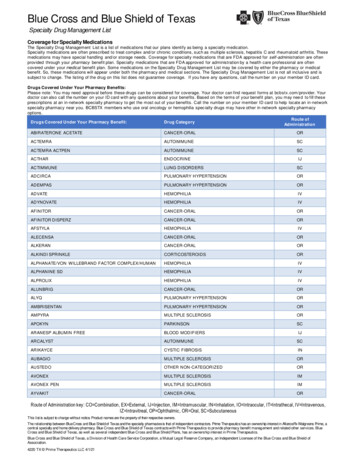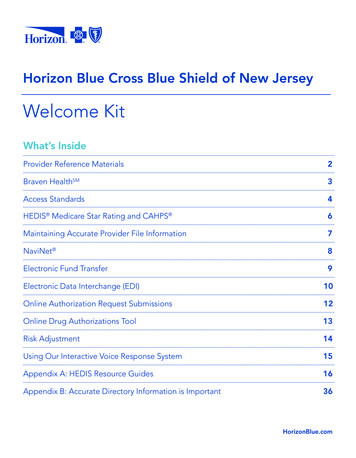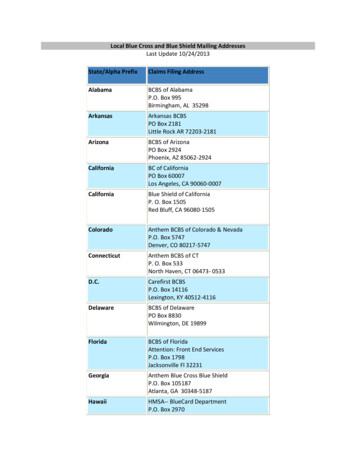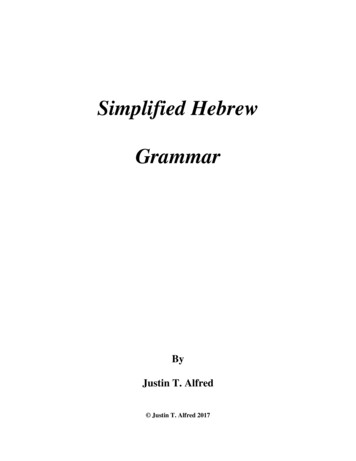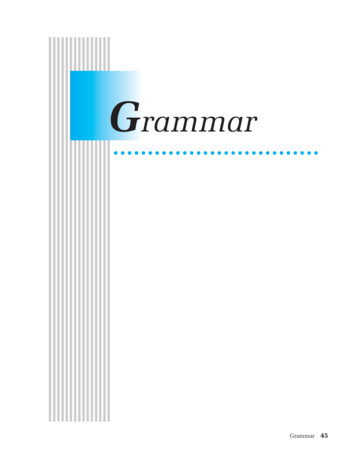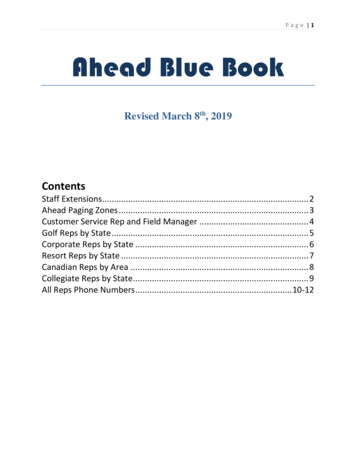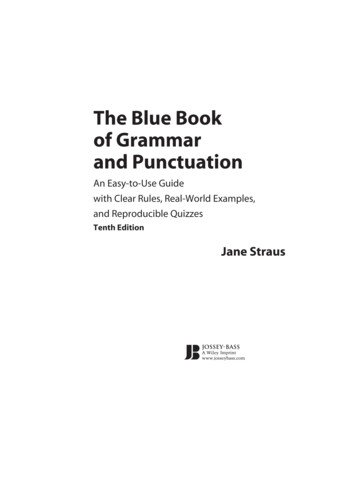
Transcription
The Blue Bookof Grammarand PunctuationAn Easy-to-Use Guidewith Clear Rules, Real-World Examples,and Reproducible QuizzesTenth EditionJane Straus
The Blue Bookof Grammarand PunctuationAn Easy-to-Use Guidewith Clear Rules, Real-World Examples,and Reproducible QuizzesTenth EditionJane Straus
Copyright 2008 by Jane Straus. All rights reserved.Published by Jossey-BassA Wiley Imprint989 Market Street, San Francisco, CA 94103-1741www.josseybass.comNo part of this publication may be reproduced, stored in a retrieval system, or transmitted in any form orby any means, electronic, mechanical, photocopying, recording, scanning, or otherwise, except aspermitted under Section 107 or 108 of the 1976 United States Copyright Act, without either the priorwritten permission of the publisher, or authorization through payment of the appropriate per-copy fee tothe Copyright Clearance Center, Inc., 222 Rosewood Drive, Danvers, MA 01923, 978-750-8400, fax978-646-8600, or on the Web at www.copyright.com. Requests to the publisher for permission should beaddressed to the Permissions Department, John Wiley & Sons, Inc., 111 River Street, Hoboken, NJ 07030,201-748-6011, fax 201-748-6008, or online at http://www.wiley.com/go/permission.Readers should be aware that Internet Web sites offered as citations and/or sources for further informationmay have changed or disappeared between the time this was written and when it is read.Limit of Liability/Disclaimer of Warranty: While the publisher and author have used their best efforts inpreparing this book, they make no representations or warranties with respect to the accuracy orcompleteness of the contents of this book and specifically disclaim any implied warranties ofmerchantability or fitness for a particular purpose. No warranty may be created or extended by salesrepresentatives or written sales materials. The advice and strategies contained herein may not be suitablefor your situation. You should consult with a professional where appropriate. Neither the publisher norauthor shall be liable for any loss of profit or any other commercial damages, including but not limited tospecial, incidental, consequential, or other damages.Jossey-Bass books and products are available through most bookstores. To contact Jossey-Bass directly callour Customer Care Department within the U.S. at 800-956-7739, outside the U.S. at 317-572-3986, or fax317-572-4002.Jossey-Bass also publishes its books in a variety of electronic formats. Some content that appears in printmay not be available in electronic books.ISBN: 978–0–470–22268–3Printed in the United States of AmericaTENTH EDITIONPB Printing10 9 8 7 6 5 4 3 2 1
ContentsAcknowledgmentsxiiiAbout the AuthorxvForeword by Mignon Fogarty (Grammar Girl)Introduction1GrammarFinding Subjects and Verbsxviixix11Finding verbsUsing verbs to find subjectsYou as an understood subjectMultiple subjects and verbs in a sentenceSubject and Verb Agreement2Singular vs. plural verbsWith or and norWith either and neitherWith conjunctions such as and and butWith interrupting expressionsWith pronouns as subjects such as each, everyone, and anybodyWith portions such as percent, fraction, part, some, all, and noneWith here and thereWith sums of moneyWith who, that, and whichWith collective nounsPronouns6Subject Case (Nominative): I, you, he, she, it, we, theyiii
ivThe Blue Book of Grammar and PunctuationObject Case (Objective): me, you, him, her, it, us, themCorrect use of pronouns by finding clausesFollowing than or asPossessive case: mine, yours, his, hers, ours, theirs, itsIts vs. it’sUsing possessive case with gerundsReflexives: the self pronounsWho vs. Whom8Whoever vs. Whomever8That vs. Which9Adjectives and Adverbs10Adjectives modifying nouns and pronounsAdverbs modifying verbs, adjectives, and adverbs: Answering how, when, or whereWhen to add -lySense verbs: taste, smell, look, and feelGood vs. wellComparisons such as –er vs. –est and more vs. mostThis, that, these, and thoseThan vs. thenProblems with Prepositions13Ending a sentence with a prepositionAvoiding extra prepositionsWith datesOf vs. haveBetween vs. amongIn vs. intoLike vs. asEffective Writing14Concrete vs. vague languageActive vs. passive voiceClumsy construction such as there is or it wasDouble negativesSimilar grammatical formMisplaced and dangling modifiersFragments2Confusing Words and HomonymsAdvice vs. adviceAffect vs. effect16
ContentsvLay vs. lieTheir vs. there vs. they’reHundreds more confusing words and homonyms3Punctuation52Spacing with Punctuation52Periods52With complete sentencesWith indirect questionsWith abbreviations at the end of a sentenceEllipsis Marks53With omitted words or sentencesSpacingCommas54To separate three or more itemsTo separate adjectivesWith namesWith datesWith city and stateWith degrees and titlesTo set off interrupting expressionsWith weak and strong clausesAfter phrasesWith nonessential descriptionsWith conjunctionsTo avoid confusionComma spliceRun-on sentenceTo introduce quoted materialTo separate statements from questionsTo separate contrasting parts of a sentenceWith introductory words such as well and yesWith interrupters such as however and thereforeWith introductory words such as namely, that is, for example,e.g., and i.e. when they are followed by a series of itemsSemicolonsTo join two sentences without a conjunctionWith introductory words such as namely, that is, for example, e.g.,and i.e.when they introduce a complete sentenceTo avoid confusion where commas already exist57
viThe Blue Book of Grammar and PunctuationWith sentences that have multiple clausesColons58To attach lists to sentencesSpacingWith tabular formattingWith long quotationsAfter the salutation in a business letterQuestion Marks60Exclamation Points61Quotation Marks61Placement with periods, commas, question marks, and semicolonsUse of single quotation marksUse of sicParentheses62For clarificationFor asidesTo enclose numbersWith complete ar possessionPlural possessionWith names ending in sWith compound nouns such as mother-in-law’sTo show joint possessionWith possessive pronouns such as his, hers, and oursTo show plurals of numbers, letters, and abbreviationsWith gerunds (-ing words)HyphensBetween wordsWith compound verbsWith compound adjectivesWith -ly wordsWith compound adverbsWith compound numbersWith prefixesWith double vowels such as semi-invalidWith double e and double o such as preemptive and coordinate65
ContentsviiWith mixed vowels such as proactiveWith vowels and consonants such as noncomplianceWith self, ex, and reHyphens Between WordsHyphens with PrefixesDashes68En DashEm Dash4Capitalization70Beginning a sentence or quoted sentenceProper nounsTitlesGovernment officialsPoints of the compassTitles of publicationsWith state, federal, and other government bodiesWith seasonsWith salutationsWith words derived from proper nouns such as English5Writing Numbers73Using figures vs. spelling outMixed quantities within the same sentenceFractionsLarge numbersDecimalsDatesTimeCompound numbers6QuizzesGrammar Pretest7676Finding Subjects and Verbs—Quiz 178Finding Subjects and Verbs—Quiz 278Subject and Verb Agreement—Quiz 179Subject and Verb Agreement—Quiz 280Pronouns—Quiz 181Pronouns—Quiz 281Who, Whom, Whoever, Whomever—Quiz 182Who, Whom, Whoever, Whomever—Quiz 283Who, Whom, That, Which—Quiz 184
viiiThe Blue Book of Grammar and PunctuationWho, Whom, That, Which—Quiz 284Adjectives and Adverbs—Quiz 185Adjectives and Adverbs—Quiz 286Problems with Prepositions—Quiz 187Problems with Prepositions—Quiz 287Affect vs. Effect—Quiz 188Affect vs. Effect—Quiz 288Lay vs. Lie—Quiz 189Lay vs. Lie—Quiz 290Advice vs. Advise—Quiz 190Advice vs. Advise—Quiz 291Their vs. There vs. They’re—Quiz 191Their vs. There vs. They’re—Quiz 292More Confusing Words and Homonyms—Quiz 192More Confusing Words and Homonyms—Quiz 293More Confusing Words and Homonyms—Quiz 394Effective Writing—Quiz 195Effective Writing—Quiz 297Grammar Mastery TestPunctuation, Capitalization, and Writing Numbers Pretest98100Commas—Quiz 1102Commas—Quiz 2102Semicolons and Colons—Quiz 1103Semicolons and Colons—Quiz 2104Question Marks, Quotation Marks, and Parentheses—Quiz 1105Question Marks, Quotation Marks, and Parentheses—Quiz 2106Apostrophes—Quiz 1106Apostrophes—Quiz 2107Hyphens Between Words—Quiz 1107Hyphens Between Words—Quiz 2108Hyphens with -ly Words—Quiz 1108Hyphens with -ly Words—Quiz 2109Hyphens with Prefixes—Quiz 1109Hyphens with Prefixes—Quiz 2110Hyphens with re- Words—Quiz 1110Hyphens with re- Words—Quiz 2111Capitalization—Quiz 1111Capitalization—Quiz 2112Writing Numbers—Quiz 1112
ContentsWriting Numbers—Quiz 2Punctuation, Capitalization, and Writing Numbers Mastery Test7Answers to QuizzesGrammar Pretestix113113116116Finding Subjects and Verbs—Quiz 1118Finding Subjects and Verbs—Quiz 2118Subject and Verb Agreement—Quiz 1119Subject and Verb Agreement—Quiz 2120Pronouns—Quiz 1120Pronouns—Quiz 2121Who, Whom, Whoever, Whomever—Quiz 1122Who, Whom, Whoever, Whomever—Quiz 2123Who, Whom, That, Which—Quiz 1124Who, Whom, That, Which—Quiz 2124Adjectives and Adverbs—Quiz 1125Adjectives and Adverbs—Quiz 2125Problems with Prepositions—Quiz 1126Problems with Prepositions—Quiz 2127Affect vs. Effect—Quiz 1127Affect vs. Effect—Quiz 2128Lay vs. Lie—Quiz 1128Lay vs. Lie—Quiz 2129Advice vs. Advise—Quiz 1129Advice vs. Advise—Quiz 2130Their vs. There vs. They’re—Quiz 1130Their vs. There vs. They’re—Quiz 2131More Confusing Words and Homonyms—Quiz 1131More Confusing Words and Homonyms—Quiz 2132More Confusing Words and Homonyms—Quiz 3133Effective Writing—Quiz 1134Effective Writing—Quiz 2135Grammar Mastery Test136Punctuation, Capitalization, and Writing Numbers Pretest138Commas—Quiz 1140Commas—Quiz 2140Semicolons and Colons—Quiz 1141Semicolons and Colons—Quiz 2142Question Marks, Quotation Marks, and Parentheses—Quiz 1143Question Marks, Quotation Marks, and Parentheses—Quiz 2144
xThe Blue Book of Grammar and PunctuationApostrophes—Quiz 1144Apostrophes—Quiz 2145Hyphens Between Words—Quiz 1145Hyphens Between Words—Quiz 2146Hyphens with -ly Words—Quiz 1146Hyphens with -ly Words—Quiz 2147Hyphens with Prefixes—Quiz 1147Hyphens with Prefixes—Quiz 2147Hyphens with re- Words—Quiz 1148Hyphens with re- Words—Quiz 2148Capitalization—Quiz 1149Capitalization—Quiz 2149Writing Numbers—Quiz 1150Writing Numbers—Quiz 2150Punctuation, Capitalization, and Writing Numbers Mastery Test151
To my wonderful husband, Lester Kaufman, who spares me fromembarrassment by being the most tenacious, relentlessproofreader a gal could ask for. (It’s fine to end a sentence with apreposition . . . really!)
AcknowledgmentsCreating and publishing a reference guide and workbook that is popular,easy to understand, and tempting to use requires the input of many. Mythanks go to the following: my parents who, as immigrants to the UnitedStates, passed their meticulousness about speaking and writing well alongto me; Gary Klehr for helping to name the book many years ago and fortireless structural editing; my husband, Lester Kaufman, for catching somany mistakes before they found their way into print; our daughter, Zoe,for her wise counsel about content and much more; my literary agent, CathyFowler, for her steadfast belief in the book’s value; Marjorie McAneny atJossey-Bass Publishers for enthusiastically rolling out the red carpet; andthe thousands of loyal readers and viewers of my Web site who, by offeringvaluable input daily, help shape every rule, example, and quiz.xiii
About the AuthorIN 1975, when the State of California was formulating its plan for a trainingbranch, no one knew what employees wanted or needed. Jane Straus,then an undergraduate at the University of California at Davis seekingwork as a waitress, was offered the job of finding out in exchange forthree units toward graduation. From her interviews with hundreds of Stateemployees, Jane discovered that they needed English and math programsto pass the civil service promotional exams. She sent in her results, receivedher units, and kept knocking on restaurant doors. One day, she got a call:’’Jane, it looks as though you can write well. Can you teach a class inEnglish?’’ Desperate and too naı̈ve to know better, Jane answered witha resounding, ’’Sure.’’ This is how a star was born—or at least began torise in the sky. Within weeks, thirty employees signed up for a one-daytrial program in Basic English Grammar and Punctuation Skills taughtby (twenty-year-old) ‘‘Training Consultant’’ Jane Straus. To prepare, Janescoured the library for materials but found no books that conveyed the rulesof English in—well—plain English. So she wrote the rules her way, madeup some exercises, ran off some copies, and hoped for the best that first dayof class. Fortunately, the class raved about Jane and her material, but shestill searched for ’’real’’ work. What she didn’t know was that the phonesat the newly formed State Training Center were ringing off the hook. Wordhad spread quickly. More and more State employees demanded that theyget an equal opportunity to benefit from Jane’s seminar. Eventually, Janetaught many different courses for state and federal employees as well asfor the private sector and nonprofit organizations. Some of the programsshe designed included Public Speaking (where she met her wonderfulhusband), Effective Meeting Skills, and Communicating with DifferentPersonality Styles. While developing these programs, she continued toxv
xviAbout the Authorrefine her English material, eventually turning it into The Blue Book ofGrammar and Punctuation.Jane believed that this easy-to-use guide and workbook should beoffered to everyone as a self-help tool. When the Internet was born, shesaw a perfect opportunity to cast the net wide and offered the entirecontents of The Blue Book online for free, as it still is today. During hertenure as a consultant, Jane also began a coaching and consulting practiceto help individuals, couples, families, and organizations communicatetruthfully, effectively, and compassionately. Her corporate retreats andkeynote speeches have made her a sought-after speaker, and her privatelife-coaching practice thrives. In 2003, at the top of her game, Jane wasdiagnosed with a brain tumor, giving her an opportunity to assess her life(and perhaps her imminent death). Gratefully, the noncancerous tumorwas successfully removed. Also gone were Jane’s fears about taking herself-help work to the next level. She wrote her inspirational book, EnoughIs Enough! Stop Enduring and Start Living Your Extraordinary Life, over thenext year and it was published in 2005 by Jossey-Bass. She has becomea favorite guest expert in the media and writes articles for publication.People often ask Jane how she blends her English teacher persona with herwit and wisdom in matters of the heart and spirit. Her answer is, ’’It’s allself-help. Whether I’m figuring out a way to explain the use of a semicolonor working with someone who wants to stop suffering from addiction,resentment, or shame, there is a path. My art and skill lie in making thatpath look and feel like a stroll instead of a steep climb up a treacherousmountain. It’s the ultimate gratification when someone I’m working withsays, ’I get it. I didn’t know it could be so easy.’ Whether they are referringto the distinction between who and whom or they’re celebrating life in newand extraordinary ways because of our work together, it’s music to myears and a gift to my spirit.’’
ForewordThe Blue Book of Grammar and Punctuation succeeds at a rare feat: beingmany things to many people. It’s a refresher for experts, a reference for laypeople, and a lesson plan for teachers. Now in its tenth edition, The BlueBook is a masterpiece of clarity and usefulness.I first became aware of The Blue Book when I was working on thetranscripts for my audio podcast, Grammar Girl’s Quick and Dirty Tips forBetter Writing. Much like Jane at the beginning of her career as a corporatetrainer specializing in English instruction, I embarked upon my role as ausage commentator with a love of language, an optimistic outlook, and noidea what I was getting myself into.Also like Jane, my efforts met with unexpected success, and I suddenlyfound myself on tight deadlines and knee deep in every manner of languagebook. My listeners and readers seemed to revel in their role as after-the-factcopy editors, and I needed all the help I could get. I noticed that one Website kept coming up in my searches— Jane’s Grammarbook.com. Everyentry provided a clear answer to my questions, and I just had to have thebook for myself.I reach for The Blue Book almost every day because it covers the mostcommon grammar and punctuation questions. I’m also excited about thetenth edition’s inclusion of Confusing Words and Homonyms. For me,the book serves both as a refresher and as a quick double check on whatI’m pretty sure I already know. But for businesspeople who aren’t alreadystuffed full of English usage rules, this book is an essential reference tohave on hand when writing e-mails, business letters, reports, and the like.Should you use affect or effect? A semicolon or comma? The Blue Book isyour trusty guide.xvii
xviiiForewordIn addition, with dozens of quizzes specifically designed for before-andafter testing, The Blue Book is perfect for classroom teachers and homeschoolers. An instructor can pretest students, go through a lesson, andthen administer a posttest to show students how much they have learned.Even though I’m not in school, I took all the quizzes. Is there anyone whodoesn’t like quizzes? There’s a reason practically every magazine includesthem!As it goes into its tenth edition, The Blue Book deserves its reputationas a true classic. Author Jane Straus has a gift for distilling the rules downto their essence and clarifying with real-world examples to create thiscomprehensible learning tool and reference guide. This book will help younot only feel smarter; you will be smarter and have fun in the process.Gilbert, ArizonaJune 2007Mignon Fogarty—Grammar Girlwww.quickanddirtytips.com
IntroductionNOW IN ITS TENTH EDITION, The Blue Book of Grammar and Punctuationwill help you write and speak with confidence. Contrary to what may beyour past experience, you don’t have to be an English major to understandgrammar and punctuation. You just need rules that are easy to understandwith real-world examples.Whether you are an instructor teaching students the rules of Englishor a student, executive, professional writer, or avid blogger honing yourgrammar and punctuation skills, this book will help you zip through tests(including the SAT), reports, essays, letters, e-mails, and resumes and willmake you (or at least your writing) look impressive.This book is logical, self-paced, and fun to use, with scores of interestingand challenging quizzes that may be photocopied to your heart’s content.Best of all, you can look forward to instant gratification because the answersare included.If you don’t want to interrupt your thoughts to figure out where thenext comma should go or whether to write who or whom, you will find TheBlue Book a pleasure to use. Dedicated to eliminating unnecessary jargon,it highlights the most important grammar, punctuation, and capitalizationrules and clarifies the most commonly confused words.The Blue Book begins with Chapter One, Grammar. Here, you will learnhow to locate Subjects and Verbs so that you can make sure they agreewith each other. Then you will move on to Pronoun Usage so that youwill know whether to write I or me, he or him, who or whom, and so forth.From there, in the Adjective and Adverb chapter, you will discover whysome words have -ly added to them and why you must say, ‘‘She did wellon the test,’’ not, ‘‘She did good on the test.’’ After that, you will breezethrough Prepositions where you will find some surprising rules and wexix
xxIntroductionwill debunk at least one myth. Hint: Is it safe to ask, ‘‘What are you talkingabout?’’ or must we ask, ‘‘About what are you talking?’’The Effective Writing section of this chapter will give you helpful tips tobe able to construct sentences and paragraphs that flow gracefully, makingit easier to write quickly and well.After that, you will enjoy spending time reading all about affect vs.effect, lay vs. lie, their vs. there vs. they’re, and its vs. it’s in Chapter Two,Confusing Words and Homonyms. I have provided hundreds of words foryou in this chapter so you will never have to be confused between fartherand further, continual and continuous, and all the rest of the trickiest wordsin the English language.Chapter Three, Punctuation, contains all the usual suspects: Periods(including spacing suggestions), Ellipsis marks, Commas, Semicolons,Colons, Question marks, Quotation marks, Parentheses, Apostrophes,Hyphens, and Dashes. The best part about these chapters is that youwill find an abundance of examples that you run across every day.Then comes Chapter Four, Capitalization, where you will get yourmost vexing questions answered, such as which words to capitalize in atitle, when to capitalize job titles like president or director, and if it’s reallytrue that summer and fall are lowercase.In Chapter Five, Writing Numbers, you will learn when to use numeralsand when to write out numbers as well as how to write both fractions andlarge numbers.Promise not to skip the Quizzes, Pretests, or Mastery Tests in ChapterSix. The more you practice, the more confident you will become. Once youget over any fears about test taking, I think you will find the quizzes bothfun and intriguing. You will find the answers in Chapter Seven.Please visit www.Grammarbook.com, where you will find all thequizzes in the book in multiple-choice, interactive format. Plus, if you area teacher or really jazzed about improving your English skills, on this Website you will find: Hundreds of additional downloadable, interactive quizzes in the Subscription area All the rules and examples you see in the book A sign-up box on the home page for my free weekly e-newsletter withtips and articles
Introductionxxi My blog Recommendations for further reading and studyI hope you find The Blue Book to be both enjoyable and invaluable.To send an acknowledgment (always appreciated) or to offer feedback orsuggestions, write to me at Jane@janestraus.com.
Chapter 1GrammarFinding Subjects and VerbsNoteWe will use the standard here of underlining subjects once and verbs twice.Being able to find the right subject and verb will help you correct errorsof agreement.Example: The list of items is/are on the desk.If you know that list is the subject, then you will chooseis for the verb.Being able to identify the subject and verb correctly will also help you withcommas and semicolons as you will see later.Definition. A Verb is a word that shows action (runs, hits, slides) orstate of being (is, are, was, were, am, and so on).Examples: He ran around the block.You are my friend.Rule 1. If a verb follows to, it is called an infinitive phrase and is not themain verb. You will find the main verb either before or after the infinitivephrase.Examples: I like to walk.The efforts to get her elected succeeded.Definition. A Subject is the noun or pronoun that performs the verb.Example: The woman hurried.Woman is the subject.1
2The Blue Book of Grammar and PunctuationRule 2. A subject will come before a phrase beginning with of .Example: A bouquet of yellow roses will lend color and fragrance to theroom.Rule 3. To find the subject and verb, always find the verb first. Then askwho or what performed the verb.Examples: The jet engine passed inspection. Passed is the verb. Who orwhat passed? The engine, so engine is the subject. If youincluded the word jet as the subject, lightning will notstrike you. Technically, jet is an adjective here and is partof what is known as the complete subject.From the ceiling hung the chandelier. The verb is hung.Now, if you think ceiling is the subject, slow down. Askwho or what hung. The answer is chandelier, not ceiling.Therefore, chandelier is the subject.Rule 4. Any request or command such as ‘‘Stop!’’ or ‘‘Walk quickly.’’ hasthe understood subject you because if we ask who is to stop or walk quickly,the answer must be you.Example: (You) Please bring me some coffee.Bring is the verb. Who is to do the bringing? Youunderstood.Rule 5. Sentences often have more than one subject, more than one verb,or pairs of subjects and verbs.Examples: I like cake and he likes ice cream.Two pairs of subjects and verbsHe and I like cake.Two subjects and one verbShe lifts weights and jogs daily.One subject and two verbsSubject and Verb AgreementBasic Rule. The basic rule states that a singular subject takes a singularverb, while a plural subject takes a plural verb.NoteThe trick is in knowing whether the subject is singular or plural. The next trick isrecognizing a singular or plural verb.
Grammar3Hint: Verbs do not form their plurals by adding an s as nouns do. Inorder to determine which verb is singular and which one is plural, think ofwhich verb you would use with he or she and which verb you would usewith they.Example: talks, talkWhich one is the singular form? Which word would youuse with he? We say, ‘‘He talks.’’ Therefore, talks issingular. We say, ‘‘They talk.’’ Therefore, talk is plural.Rule 1. Two singular subjects connected by or or nor require a singularverb.Example: My aunt or my uncle is arriving by train today.Rule 2. Two singular subjects connected by either/or or neither/nor require asingular verb as in Rule 1.Examples: Neither Juan nor Carmen is available.Either Kiana or Casey is helping today with stage decorations.Rule 3. When I is one of the two subjects connected by either/or orneither/nor, put it second and follow it with the singular verb am.Example: Neither she nor I am going to the festival.Rule 4. When a singular subject is connected by or or nor to a plural subject,put the plural subject last and use a plural verb.Example: The serving bowl or the plates go on that shelf.Rule 5. When a singular and plural subject are connected by either/or orneither/nor, put the plural subject last and use a plural verb.Example: Neither Jenny nor the others are available.Rule 6. As a general rule, use a plural verb with two or more subjectswhen they are connected by and.Example: A car and a bike are my means of transportation.Rule 7. Sometimes the subject is separated from the verb by words suchas along with, as well as, besides, or not. Ignore these expressions whendetermining whether to use a singular or plural verb.
4The Blue Book of Grammar and PunctuationExamples: The politician, along with the newsmen, is expected shortly.Excitement, as well as nervousness, is the cause of hershaking .Rule 8. The pronouns each, everyone, every one, everybody, anyone, anybody,someone, and somebody are singular and require singular verbs. Do not bemisled by what follows of .Examples: Each of the girls sings well.Every one of the cakes is gone.NoteEveryone is one word when it means everybody. Every one is two words when themeaning is each one.Rule 9. With words that indicate portions—percent, fraction, part,majority, some, all, none, remainder, and so forth—look at the noun inyour of phrase (object of the preposition) to determine whether to usea singular or plural verb. If the object of the preposition is singular,use a singular verb. If the object of the preposition is plural, use aplural verb.Examples: Fifty percent of the pie has disappeared.Pie is the object of the preposition of.Fifty percent of the pies have disappeared.Pies is the object of the preposition.One-third of the city is unemployed.One-third of the people are unemployed.NoteHyphenate all spelled-out fractions.All of the pie is gone.All of the pies are gone.Some of the pie is missing.Some of the pies are missing.None of the garbage was picked up.None of the sentences were punctuated correctly.Of all her books, none have sold as well as the first one.
Grammar5NoteApparently, the SAT testing service considers none as a singular word only. However,according to Merriam Webster’s Dictionary of English Usage, ‘‘Clearly none has beenboth singular and plural since Old English and still is. The notion that it is singularonly is a myth of unknown origin that appears to have arisen in the 19th century.If in context it seems like a singular to you, use a singular verb; if it seems like aplural, use a plural verb. Both are acceptable beyond serious criticism’’ (p. 664).When none is clearly intended to mean not one or not any, it is followed by asingular verb.Rule 10. When either and neither are subjects, they always take singularverbs.Examples: Neither of them is available to speak right now.Either of us is capable of doing the job.Rule 11. The words here and there have generally been labeled as adverbseven though they indicate place. In sentences beginning with here or there,the subject follows the verb.Examples: There are four hurdles to jump.There is a high hurdle to jump.Rule 12. Use a singular verb with sums of money or periods of time.Examples: Ten dollars is a high price to pay.Five years is the maximum sentence for that offense.Rule 13. Sometimes the pronoun who, that, or which is the subject of a verbin the middle of the sentence. The pronouns who, that, and which becomesingular or plural according to the noun directly in front of them. So, ifthat noun is singular, use a singular verb. If it is plural, use a plural verb.Examples: Salma is the scientist who writes/write the reports.The word in front of who is scientist, which is singular.Therefore, use the singular verb writes.He is one of the men who does/do the work.The word in front of who is men, which is plural.Therefore, use the plural verb do.Rule 14. Collective nouns such as team and staff may be either singular orplural depending o
Punctuation, Capitalization, and Writing Numbers Mastery Test 113 7 Answers to Quizzes 116 Grammar Pretest 116 Finding Subjects and Verbs—Quiz 1 118 Finding Subjects and Verbs—Quiz 2 118 Subject and Verb Agreement—Quiz 1 119 Subject and Verb Agreement—Quiz 2 120 Pronouns—Quiz 1

